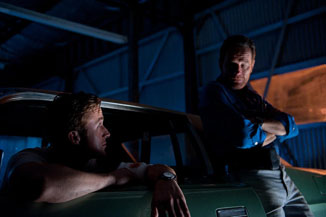Movie Review: Drive
By Matthew Huntley
September 22, 2011
BoxOfficeProphets.com

With that said, are movies of substance necessarily better than movies of style? Better is not the right word, but they are usually more impactful and memorable. Drive certainly had the potential to be more substantive, but it seems content as a technical exercise rather than telling an original story. Don’t get me wrong, it’s a sensational exercise, entertaining and well-made, but as such, it’s not going to stay imprinted on my mind as long as a strong narrative.
The movie stars Ryan Gosling, who’s simply credited as Driver, a quiet, withdrawn man of about 30 who acts as a driver-for-hire in Los Angeles and tells his clients they have him for five minutes to do whatever they need, which usually means driving the getaway car from a crime scene. He offers them no more time than that; he doesn’t take part in the illegal activity; he doesn’t carry a gun; and he doesn’t talk. He simply drives.
That’s his night job. During the day, he’s a stunt driver for the movies and an auto mechanic for Shannon (Bryan Cranston), his mentor-like boss who also books him his nighttime gigs. Driver lives in a modest apartment complex and seems to have no friends or family. That’s before he meets Irene (Carey Mulligan) and her son Benicio (Kaden Leos) from the down the hall. For the first time in what we assume to be a long time, Irene and Benicio are people he comes to care about and who show him affection in return. This explains why he turns so violent the moment he suspects they might be in danger. When Irene’s husband, Standard (Oscar Isaac), is released from prison, he’s threatened by the mob unless he robs a pawn shop. Driver agrees to help him if it means Irene and Benicio stay safe.
I appreciated that the movie didn’t make the husband just another abusive jerk. It would have been too easy for Driver and Standard to simply fight for the affection of Irene, but they come to respect each other and there’s a scene when Isaac delivers a credible and heartfelt memory, one which we sense Driver understands and envies.
The plot involves two other characters named Bernie (Albert Brooks) and Nino (Ron Perlman), both of whom are members of the Jewish mafia. Bernie has agreed to fund Shannon’s plan of restoring an old racecar and letting Driver sit behind the wheel. I won’t reveal how else Bernie and Nino intertwine in the plot, but after we meet them and hear them talk, they’re more or less relegated to standard bad guy roles. The screenplay by Hossein Amini, based on the book by James Sallis, doesn’t grant them very interesting or believable dialogue, and they end up being a distraction more than anything, in spite of their eventual connection to the other characters.
Director Nicolas Winding Refn is an ambitious filmmaker to be sure, but he isn’t interested in story as much as presentation. We know only bullet points about the characters, which are only enough for the plot to move forward. When it becomes clear the movie isn’t going to dig deeper into their pasts or motivations, our investment in them becomes limited and they merely end up as archetypes played by some very fine actors.
The last third of the picture revolves around brutal action and violence, which is effective and visceral, but still leaves us feeling empty. As much respect as I have for Drive on a technical level, right down to Newton Thomas Sigel’s exquisite cinematography and Matthew Newman’s orchestrated editing, I wanted the story to be bolder and weightier, especially with regards to the characters. Sure, they hardly ever developed the tough guys played by Steve McQueen or Charles Bronson, but that doesn’t mean they shouldn’t have. Why not take the genre further and utilize the cast’s talents instead of simply exploiting their superficial qualities?
Still, if you accept Drive as an exercise in style, it’s worth experiencing, because the style is quite impressive and beautiful. The opening sequence is masterful in the way it slowly reveals just how dynamic Driver is and how the streets of L.A. are his playground against cop cars and helicopters. The images tell us this, which is why it’s unnecessary for Shannon to speak about it later on. The soundtrack is strong, too, incorporating songs that seem to have been chosen for their aesthetic value instead of their popularity.
As for the inevitable car chase, it’s one of the better examples in recent years and starts with a sound that’s so pulsating, I doubt anyone will not be startled when they hear it, even if they expect it. Car chases are so standard these days they’re often boring to watch, but the one in Drive is more credible because we know the main character is also a professional driver. Of course, we’ve seen many other iterations of it, but it still pumps us up and leads into the final act, which is a gratuitous and excessive mix of violence and gore. Even though they don’t bear much consequence to the thin story, at least the filmmakers make them look pretty.
I knew going in that Drive was nominated for the Palme d’Or at the Cannes Film Festival, which surprises me, because it’s not THAT good. It works as a stylish action drama, and I admire its craft, but it didn’t leave me in as much awe as I was expecting. The filmmakers definitely have energy and talent, and if their technical skills could be matched by an equally captivating story, they’d probably have a masterpiece on their hands.